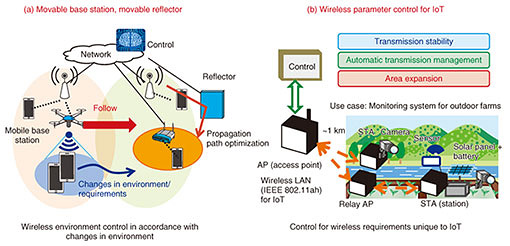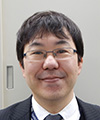 |
|||||||||||||||
|
|
|||||||||||||||
|
Feature Articles: Network-service Technologies Enabled by the All-Photonics Network for IOWN Vol. 19, No. 10, pp. 31–37, Oct. 2021. https://doi.org/10.53829/ntr202110fa3 Wireless Technologies toward Extreme NaaS—Multi-radio Proactive Control Technologies (Cradio®)AbstractServices accommodated by wireless communications require not only improvements in basic performance such as extreme high capacity, extreme low latency, and extreme mass connectivity but also the means of satisfying requirements that combine these features in sophisticated ways. The provision of services that can deliver wireless access applicable to extreme service requirements in a flexible manner whenever and wherever needed is called “extreme network as a service (NaaS).” The technologies needed for extreme NaaS are currently under development, and as elemental technologies, NTT is promoting the research and development of Multi-radio Proactive Control Technologies (Cradio®) for assessing diverse wireless conditions and proactively controlling wireless access. This article introduces an image of the world that extreme NaaS will make possible and describes Cradio. Keywords: wireless communications, Cradio®, extreme NaaS 1. Achieving extreme NaaS by combining diverse wireless access systemsWireless communications are essential to delivering ultra-high speed and ultra-low latency communication services achieved by NTT’s Innovative Optical and Wireless Network (IOWN) to the user’s terminal in an end-to-end manner. The remarkable progress made by wireless communications has made it possible to enjoy high-speed and high-capacity communications at a variety of locations. The use of wireless communications for wide-area, power-efficient communications by sensors and other devices is also progressing. Going forward, we can expect the requirements of wireless communications to expand even further through the appearance of new services driven by the expansion of communications by people and things and the fusion of the cyber and physical worlds. In the field of mobile communications, research and development has begun toward the sixth-generation mobile communications system (6G). The targets that have been established for 6G include performance improvements such as high data rates greater than 100 Gbit/s, high capacities 100 times greater than the previous generation, extreme low latency, and extreme massive connectivity as well as expanded coverage to areas heretofore unreachable such as inside aircraft, under the ocean, and space [1]. At the same time, we can expect next-generation wireless standards to accommodate wireless local area networks (LAN) and wide-area, power-efficient wireless access called low power wide area (LPWA) that can be used in a flexible manner through autonomous deployment by users using unlicensed spectrum. It is important that diverse wireless standards with different characteristics be used appropriately depending on the requirements. Individual wireless access systems each have a set of available features such as throughput, communication distance, power consumption, and stability of quality, so a network operator selects the system it needs to construct a network and provide services. In contrast, the objective in the IOWN world is to interconnect these wireless access systems naturally without the user being aware of their differences so that the performance needed in wireless communications can be obtained. This service concept has been given the name of “extreme network as a service (NaaS)” (Fig. 1). Research and development of a platform to provide extreme NaaS is now moving forward. Extreme NaaS is made possible by combining diverse optical and wireless access systems based on the full-mesh-fiber network and optical distributed computing of IOWN.
2. Achieving natural wireless access by Cradio®To achieve extreme NaaS, research and development is progressing on Multi-radio Proactive Control Technologies (Cradio®) [2] that targets and combines multiple wireless access systems as needed to achieve network connections that feel natural to the user. In mobile communications, characteristics, such as data rate, latency, reliability, coverage, and terminal power consumption, differ in accordance with the radio frequencies and communication system used. In addition, wireless systems can be highly diverse depending on the legal system governing radio waves. These can range from wireless systems operated by telecommunications carriers owning a license to those that can be set up as desired by users with no license requirement and those that share frequencies with other systems. Given that the quality of wireless communications can change from moment to moment depending on the environment due to the effects of surrounding structures and moving objects, peripheral interference, etc., it is not easy to ensure stability in communication quality. There is therefore a need to master the use of frequencies and systems with such different features, track a dynamically changing radio environment, and meet unprecedented diverse and extreme requirements such as extreme high capacity, extreme reliability, extreme mass connectivity, and extreme power efficiency. The issue is how to obtain thorough knowledge of radio-wave physical characteristics and the characteristics of each wireless access system, how to select these characteristics in an optimal manner, and how to then design and operate the network desired. Using multiple wireless access systems that require such complex and specialized knowledge in a more advanced and automatic manner can be achieved using Cradio. The concept of Cradio is illustrated in Fig. 2. The Cradio group of technologies can be broadly classified into the three areas of “assessment,” “prediction,” and “control.” Cradio achieves and interlinks these three areas of technologies in an advanced manner and cooperates with various applications to create wireless access networks applicable to diverse application requirements amid ever-changing wireless quality.
The next section summarizes key technologies now under development in each of these Cradio areas toward practical implementation. 3. Cradio elemental technologies3.1 Assessment: wireless sensing and visualization technologiesThe “assessment” area enables sensing and analysis with respect to various types of wireless information and visualizes the quality of radio signals and communications, level of congestion, usage conditions of each terminal, interference conditions, etc. (Fig. 3). It is also possible to estimate with high accuracy the level of quality that can be obtained through technologies that assess changes in structures that affect the wireless environment and that execute highly accurate positioning of terminals [3].
To give an example, a Cradio technology under development will estimate and visualize available radio-signal quality to a high degree on the basis of highly accurate three-dimensional data of buildings and other structures combined with various types of radio-wave propagation models, ray tracing, etc. that take into account various types of wireless access and frequency bands. In the past, it was common to design wireless networks using radio-zone design tools specialized for each system, but the design of multi-radio networks that organically integrate wireless networks will require visualization of integrated quality across multiple systems. Such visualization and assessment technologies being developed will enable a wireless network designer handling multiple types of wireless access to simulate communication quality in virtual space with a feeling of uniform control and assess quality that optimally takes into account frequency and system characteristics. 3.2 Prediction: wireless-quality prediction/estimation technologiesThe “prediction” area predicts and estimates the future in terms of how the communication quality of each terminal might change in the future based on wireless information that assesses and clarifies the radio-wave environment and on terminal position, peripheral environment, and other types of information. Therefore, quality degradation in unstable wireless communications can be detected beforehand so that proactive application control can be carried out such as by switching to a network with better quality or adjusting the transmission rate of a video stream. Wireless-quality prediction/estimation technologies [4] using past quality information are examples of such technologies under development. An overview of these technologies is illustrated in Fig. 4. These technologies predict and estimate communication quality such as signal intensity or throughput at a certain base station using artificial intelligence (AI) techniques based on quality data collected from past records. They learn quality information such as signal intensity or throughput measured using a variety of terminals in combination with position information, wireless-environment scan information, time-period information, etc. This makes it possible to calculate estimated values according to place and time and predict the quality of a wireless base station targeted for use. Prediction technology using AI also uses transfer learning technology based on neural networks. In this process, learning results based on signal-intensity data, which is relatively easy to collect for learning purposes, are passed on to learning based on throughput and other types of data that are not abundantly available, thereby increasing the accuracy of estimations. In the smart agriculture field, for example, field trials of this technology have been conducted [5]. In one such trial involving a self-driving tractor, stable switching among multiple wireless access systems was achieved on the basis of predicted quality. It has been shown that switching to a better wireless access system before quality degrades in this way is effective, for example, in achieving stable transmission of video for monitoring purposes.
3.3 Control: wireless-network dynamic design/control technologiesThe “control” area uses the results of assessment and prediction to control the parameters of a wireless access network and link and coordinate various wireless networks. Examples of two key technologies under development in this area are illustrated in Fig. 5. The first is movable-base-station and movable-reflector technology for automatically moving wireless base stations that have generally been fixed to optimize wireless coverage in accordance with changes in the environment. With this technology, a base station mounted on a drone or automatic transport vehicle is made to automatically move to a location where traffic is concentrated, inducing terminals to move to that location and avoid locally generated congestion [6]. A key feature of this technology is the use of clustering technology to analyze the positional relationship between wireless base stations and terminals and automatically infer an optimal arrangement. In this regard, research is being conducted on dynamic area formation technology using movable reflectors. The second technology is wireless parameter control, which is being developed to stabilize transmissions and expand the coverage area for wireless access having wide-area and low-power-consumption requirements suitable for Internet of Things (IoT) [7]. This technology controls parameters with respect to the IEEE (Institute of Electrical and Electronics Engineers) 802.11ah wireless system to achieve area expansion and transmission stability as required in particular by IoT wireless networks. A variety of control technologies in addition to the ones described above are also being researched and developed. The aim is to use these control technologies as a foundation for technology that can automatically construct and operate optimal wireless networks as needed.
4. Future outlookNTT aims to satisfy application requirements that will be expanding into diverse and extreme areas and enable users to seamlessly make connections without having to be aware of the type of wireless access being used. To this end, NTT is promoting the development of Cradio with the goal of providing them in time with the deployment of IOWN around 2030. The first step in this process is the development of a platform for implementing the various technologies making up Cradio. References
|
|||||||||||||||










